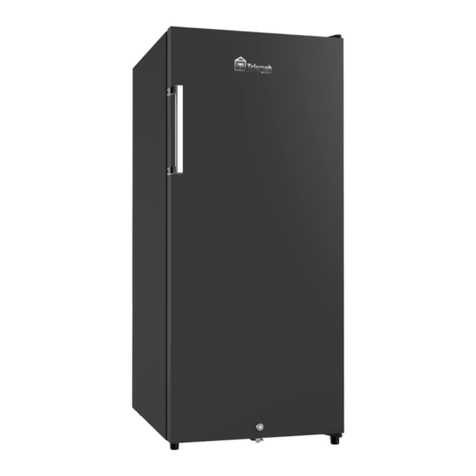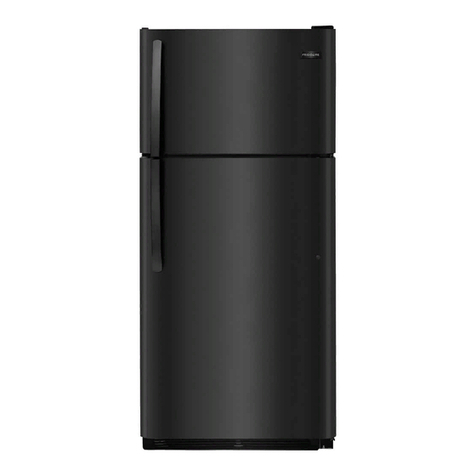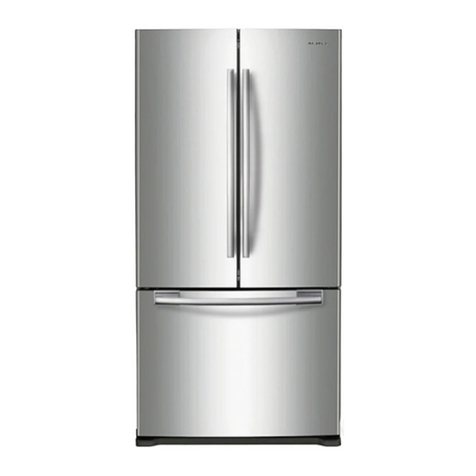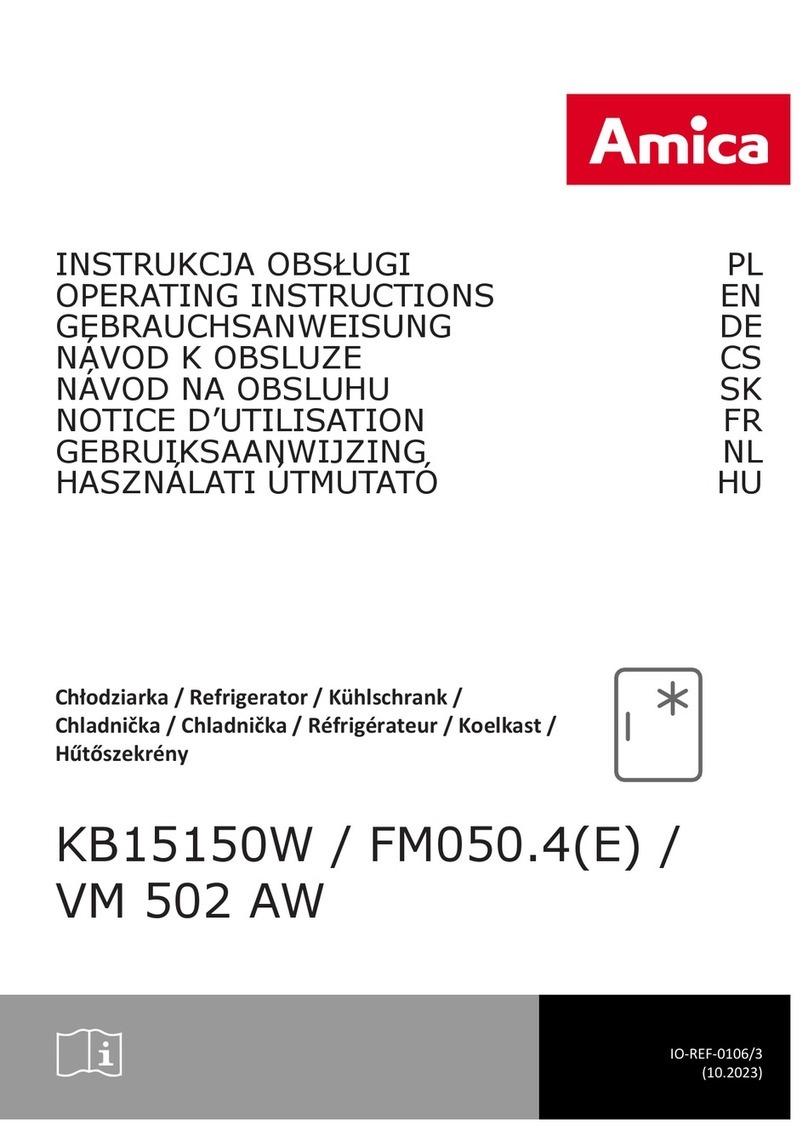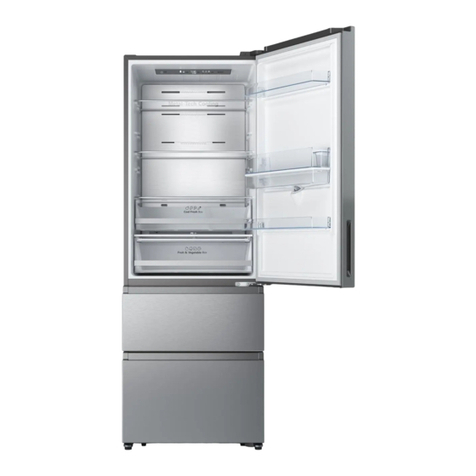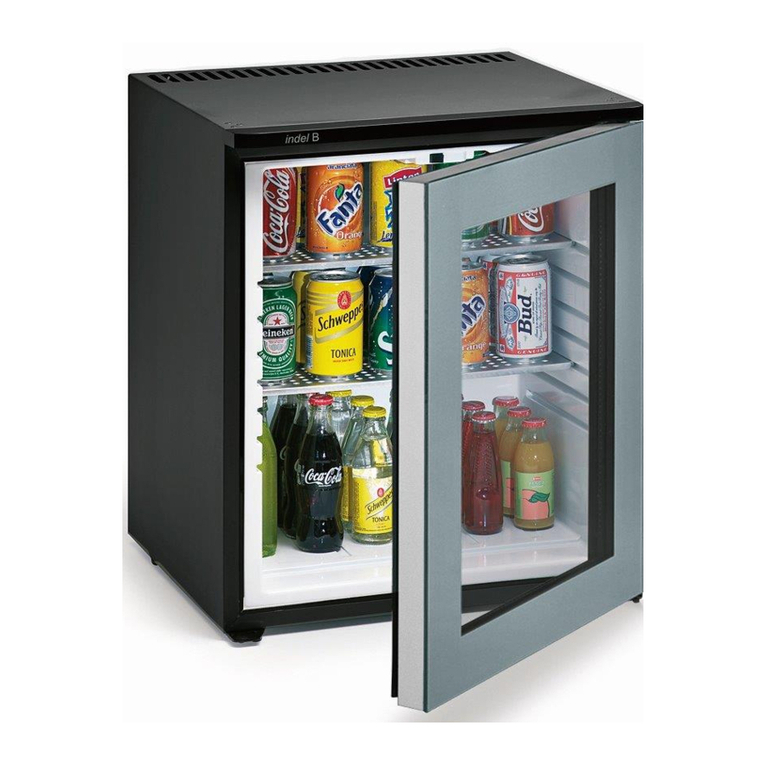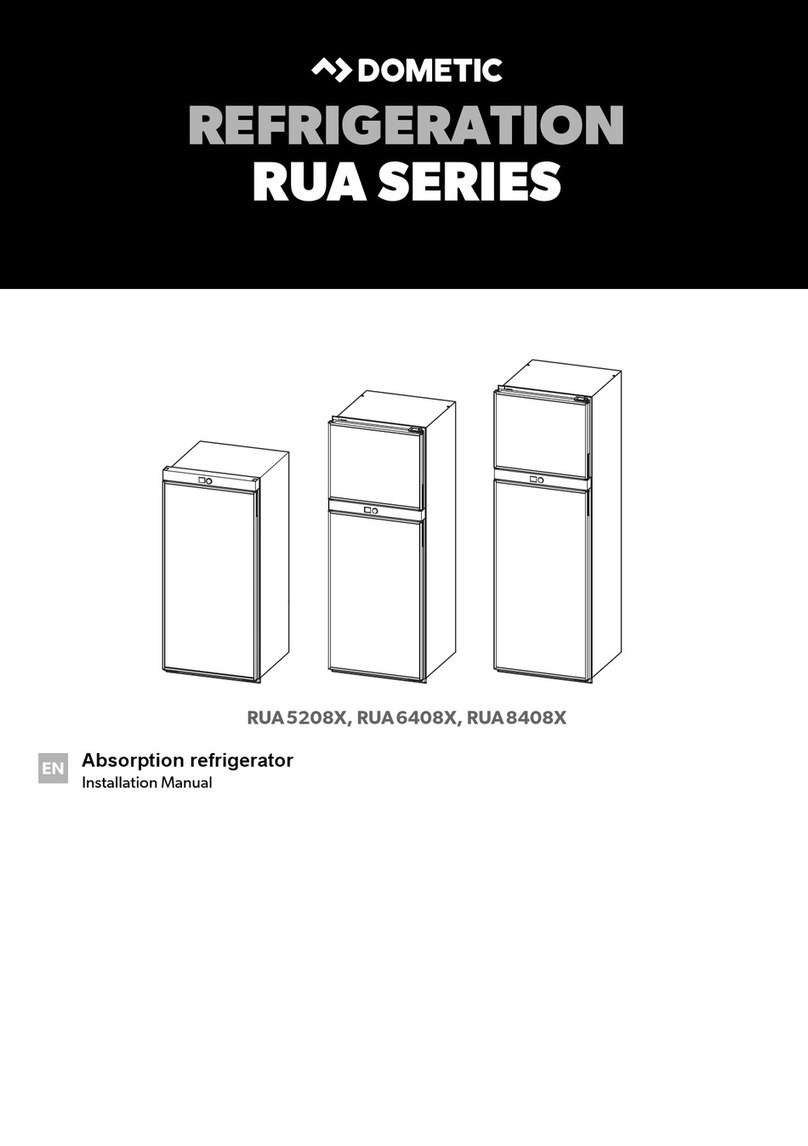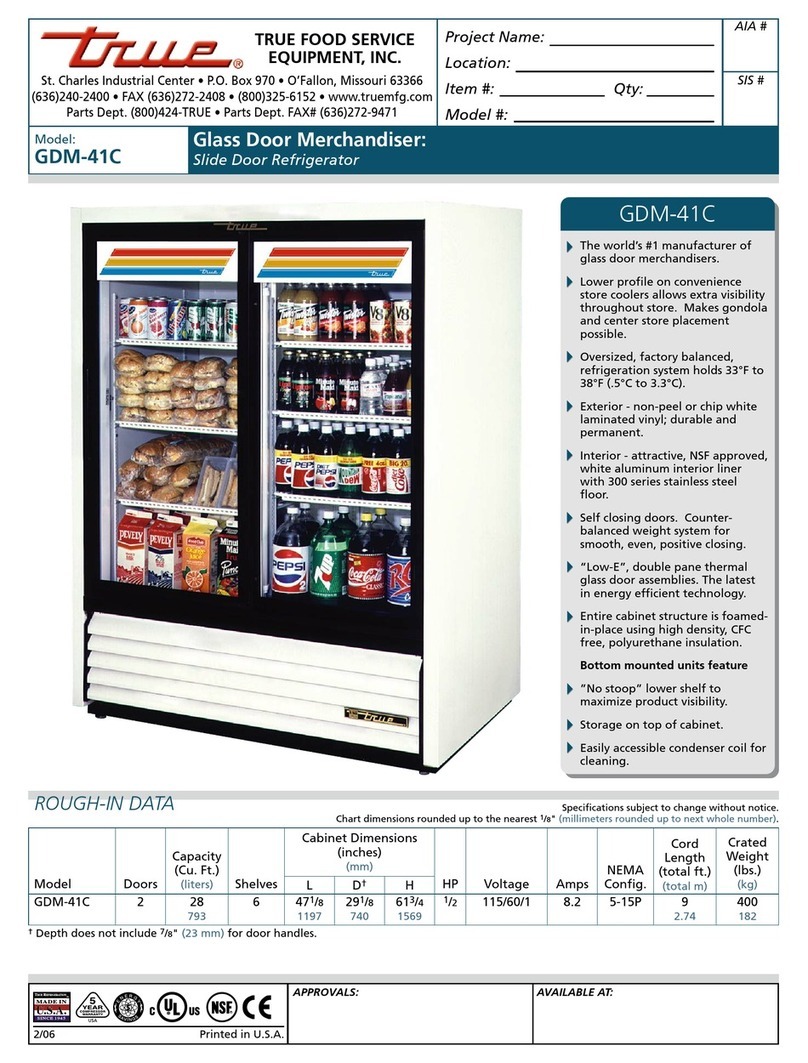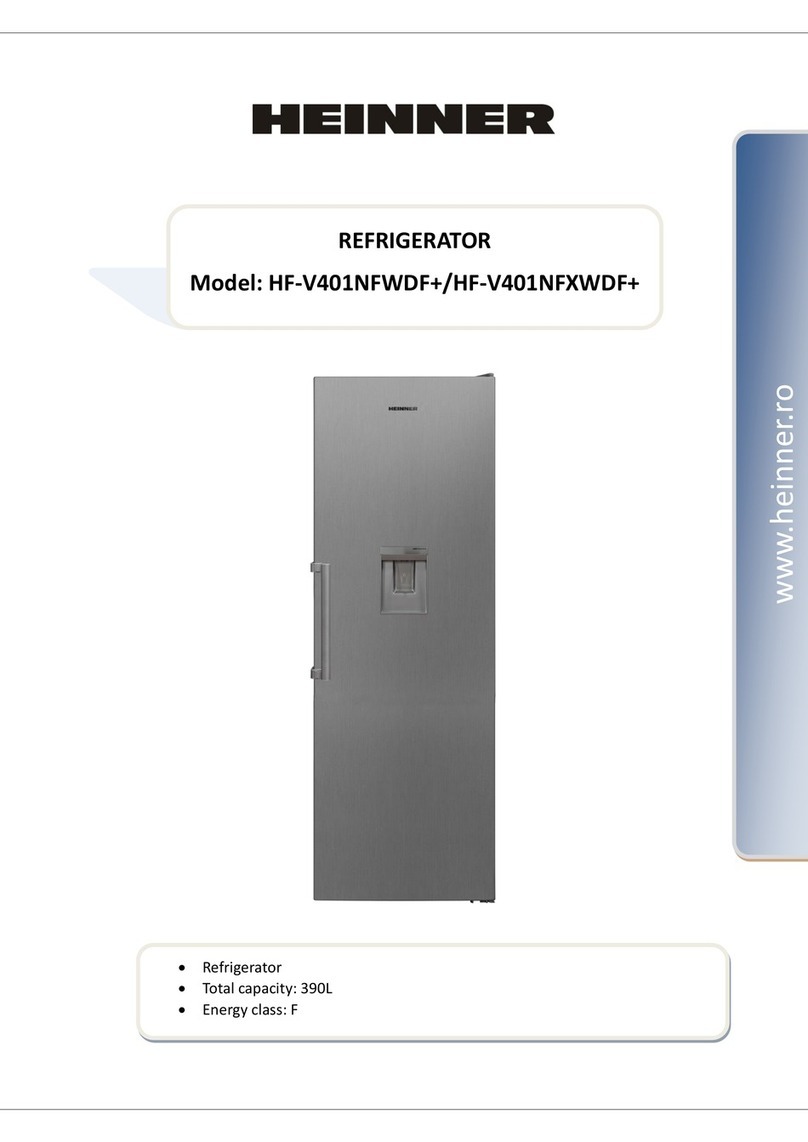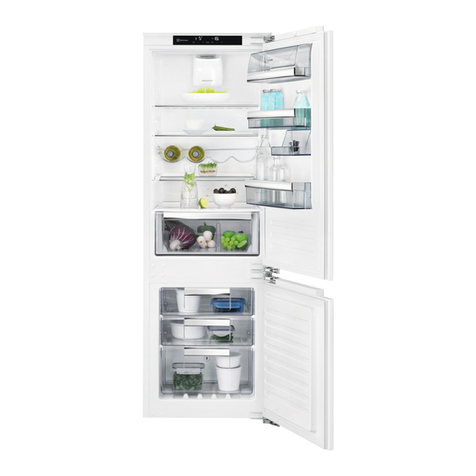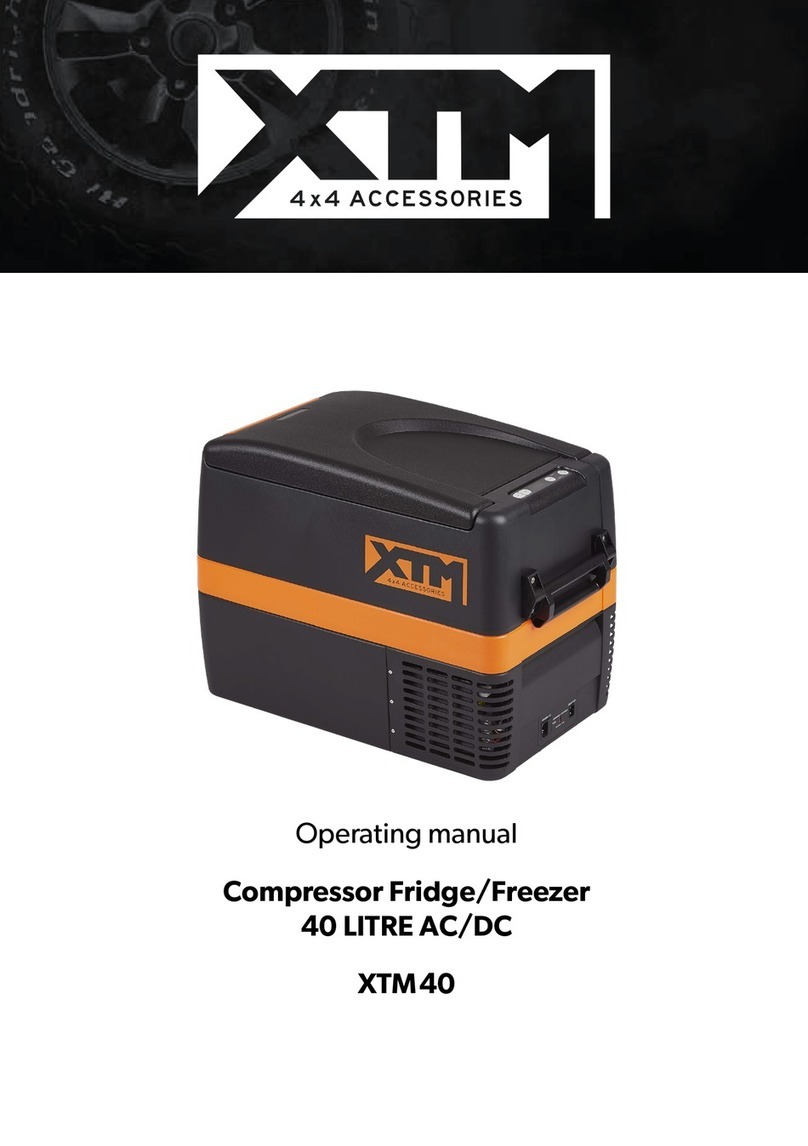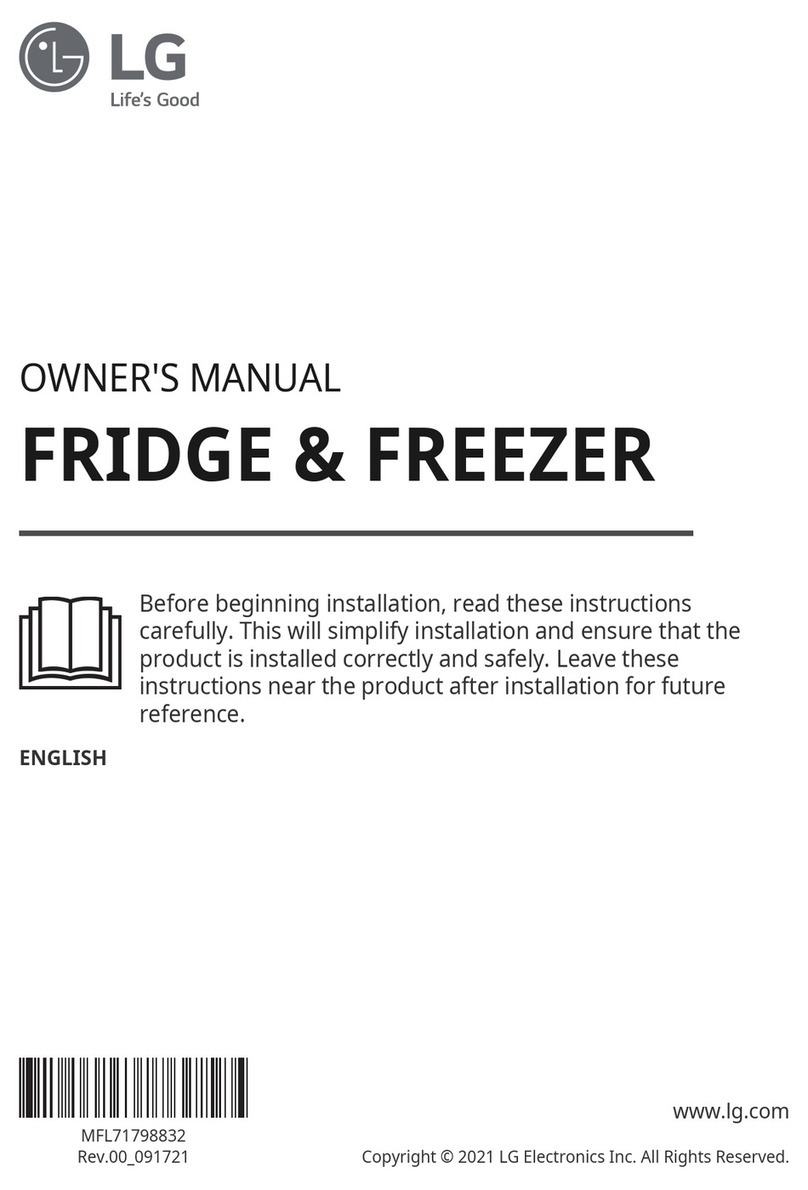Triomph TKS105VN2Z User manual

User guide
Wine Fridge
TKS105VN2Z

1
IMPORTANT SAFETY WARNINGS AND ADVICE
Please read this user guide carefully and in full before installing and using the wine fridge.
It is important that this guide is kept with the fridge for future reference.
If the wine fridge is given to another person, make sure the user guide follows the fridge so
that the new owner can properly install and use the fridge.

2
The meaning of these symbols in this user guide is outlined below.
Important information about your personal safety
and how to avoid damaging the fridge.
General information and advice
Environmental information
Fire risk
Risk of electric shock
GENERAL SAFETY
For your safety and the safety of others, please read these safety instructions
carefully before installing and using your wine fridge.
• This fridge is intended for domestic use or in similar settings such as:
o kitchen areas in an office or other business environments; and
o hotels (for guest use), motels and other residential environments.
• This wine fridge should not be used for commercial or industrial purposes or for any
purpose other than the one for which it was designed. This fridge is intended for wine
storage.
• Do not use outdoors.
• Make sure the voltage on the product matches your power supply before plugging it
in.
• Check the condition of your fridge regularly. Do not use the device if it is damaged.
Informations importantes concernant votre sécurité personelle
et comment éviter d'endommager l'appareil
Informations générales et conseils
Informations sur l'environnement
Risque d'incendie
Risque de choc électrique
Surfaces chaudes
Ne pas couvrir l'appareil
Informations importantes concernant votre sécurité personelle
et comment éviter d'endommager l'appareil
Informations générales et conseils
Informations sur l'environnement
Risque d'incendie
Risque de choc électrique
Surfaces chaudes
Ne pas couvrir l'appareil
Informations importantes concernant votre sécurité personelle
et comment éviter d'endommager l'appareil
Informations générales et conseils
Informations sur l'environnement
Risque d'incendie
Risque de choc électrique
Surfaces chaudes
Ne pas couvrir l'appareil
Informations importantes concernant votre sécurité personelle
et comment éviter d'endommager l'appareil
Informations générales et conseils
Informations sur l'environnement
Risque d'incendie
Risque de choc électrique
Surfaces chaudes
Ne pas couvrir l'appareil
Informations importantes concernant votre sécurité personelle
et comment éviter d'endommager l'appareil
Informations générales et conseils
Informations sur l'environnement
Risque d'incendie
Risque de choc électrique
Surfaces chaudes
Ne pas couvrir l'appareil

3
• Always unplug the fridge at the power socket before cleaning the unit; defrosting it;
changing the lighting lamp (when it is replaceable); moving the fridge or cleaning the
ground under the fridge.
• Do not remove the electrical socket by pulling on the cord. To remove it, hold the plug
and carefully remove it from the wall socket.
WARNING: Do not dismantle or otherwise damage the refrigeration system.
WARNING: Fire hazard. Contains refrigerant gas.
• The refrigerant gas contained in this device is isobutane (R600a). It is a flammable gas.
When transporting and installing the unit, be careful not to damage any part of the
refrigeration system.
• Do not use anything sharp to defrost the device.
• Do not use any electrical appliance inside the wine fridge.
• If the refrigeration system is damaged:
o Do not use a flame near the device.
o Avoid sparks - do not turn on an electrical appliance or electric lamp.
o Immediately ventilate the room.
For your safety, follow these installation recommendations:
The room in which the fridge will be installed must be at least 1m3 per 8 grams of refrigerant
gas. The amount of refrigerant gas contained in this fridge is shown in grams on the rating
label at the back of the fridge.

4
CHILD SAFETY
This fridge may be used by children aged 8 years or older and by persons with
reduced physical, sensory or mental abilities or lack of experience or knowledge, if
they are properly monitored, or if instructions on the safe use of the fridge have been given
and if the risks involved have been appropriately assessed.
The fridge is not a toy. Children should be monitored to ensure proper use of the fridge.
Cleaning and maintenance should not be done by children without supervision.
CONNECTION
• Check the plug and power cord regularly for damage.
• Do not use the device if the power cord or socket is damaged.
WARNING: If the power cord is damaged, it must be replaced by the manufacturer,
its after-sales service or people of similar qualification to avoid danger.

5
ELECTRICAL SAFETY
• Do not connect the fridge to a power outlet that is not protected from overloads.
• Never use power boards with multiple sockets to connect the device.
WARNING: Do not immerse the cord in water, handle the electrical components or
grip them with wet hands.
• The power socket to which the wine fridge is connected must be easily accessible, so
it can be disconnected quickly in an emergency.
• Do not unplug the fridge by pulling on the cord and do not wrap the cord around the
fridge.
• Turn the fridge off before unplugging the power cord from the socket.
• Always unplug the fridge before cleaning it.
• In the event of a fire, unplug the power cord if safe to do so or separate the unit from
the area by another means before taking fire action.
• This fridge is not intended to be activated by an external timer, by a separate remote-
control system or any other device that automatically switches on the device.
• If you do not use the device for a long period of time, please turn it off and unplug it
from the power supply.
• Do not store explosive materials such as aerosol containers with a flammable thruster
in this device.
• Any maintenance or repair of this device must be carried out by a licensed professional.
Do not attempt to repair the device yourself.

6
WARNING: Danger of Electrocution
WARNING: The ventilation openings on the fridge's casing must remain uncovered. Be
careful not to block them.
WARNING: Do not use mechanical devices inside the wine fridge.
WARNING: Do not dismantle or otherwise damage the refrigeration system.
WARNING: Do not use electrical appliances in the wine fridge, other than those
recommended by the manufacturer.

7
INSTALLATION
• This wine fridge is heavy. Be careful when moving it.
• When transporting the fridge, be careful not to damage any part of the refrigeration
system.
• Important! Leave your device vertical for 24 hours before plugging it in for the first
time so the refrigerant gas can equalise.
• If your device has been horizontal during transport, wait 48 hours before turning it on.
• After installation, make sure the fridge is not resting on the power cable.
CLEANING
• Never clean the appliance with flammable products. The fumes could cause a fire or
explosion.
• When it comes to the use, handling, cleaning and disposal of the device, refer to the
following chapters of the user guide.
WARNING: Do not use electrical appliances to clean your wine cellar.

8
Summary
IMPORTANT SECURITY WARNINGS Page 1
I DESCRIPTION OF THE APPLIANCE Page 10
II TECHNICAL CHARACTERISTICS Page 11
III INSTALLATION Page 13
A. Location Page 14
B. Unpacking the device and
discarding the packaging items Page 14
C. Foot adjustment Page 15
D. Before loading the fridge Page 15
E. Ambient temperature Page 15
F. Changing the orientation of the door Page 16
IV BEFORE USE Page 19
V USING THE FRIDGE Page 19
A. Loading your wine cellar Page 19
B. Loading plan Page 20
C. Adjustable shelves Page 21
D. Functions and temperature setting Page 23
E. Wine service temperature table Page 25
F. Power outage Page 26
VI MAINTENANCE AND CLEANING Page 27
VII TROUBLESHOOTING Page 29
VIII WARRANTY Page 31
IX CAUTION Page 32

9
This user guide is available in the following languages:
FRENCH (original version)
Other versions are a translation of the original. For an electronic version of the user guide,
including the French version, visit www.triomph-australia.com.

10
I DESCRIPTION OF THE APPLIANCE
1. Fan 1
2. Digital control panel & display
3. UV glass door
4. Metal shelves with wooden trim
5. Temperature sensors
6. Adjustable foot

11
II TECHNICAL CHARACTERISTICS
Reference
TKS105VN2Z
Model
JC-205
Power supply
220-240 V
Electric current
2.0A
Power of the lamp
2W
Dimensions L x D x H
540 x 601 x 1674 mm
Net weight
44 kg
Type of installation
Free standing
Door orientation
Right (factory setting)
Electrical scheme

12
ENERGY-RELATED PRODUCT SHEET
Brand
TRIOMPH
Reference
TKS105VN2Z
Volume
205L
The coldest storage temperature
setting that can be maintained
continuously
5˚C
Defrost
Automatic
Climate class
Climate class N/ST.
This fridge is intended
to be used in ambient
temperatures of 16-
38˚C.
Noise (dB)
45
Integrable device
No
This device is intended only for the storage of wine

13
III INSTALLATION
Recommendations:
The location you have selected for your wine fridge should:
• be well ventilated
• be away from any source of heat and direct sunlight;
• not be frequently wet (e.g. laundry, bathroom);
• have a level floor;
• have a reliable electricity supply; and
• be away from the microwave. Some microwaves do not have a wave jamming shield
so when the wine fridge is placed less than 1m from a microwave, the operation of the
wine fridge can be affected.
The fridge is designed for the N-ST climate class. Protect the device from heat (above 38 ˚C)
and cold (below 16 ˚C), dust, moisture, flooding events and splashes.
• The wine fridge must be positioned so that the power socket remains accessible after
installation.
• Unwind the power cord but do not plug it into the electricity supply immediately.
• Install your wine cellar in its final location before loading it. If the fridge is moved while
loaded, the fridge walls may be permanently deformed.
IMPORTANT: Two people are required to properly and safely install the fridge.

14
A. Location
To ensure adequate ventilation of the fridge, allow a minimum of 15 cm between the wine
fridge and the nearby walls as shown in the illustration below.
B. Unpacking the age of the device and discarding the packaging elements.
Remove all packaging, as well as protective elements inside the device's compartments,
before turning it on.
The carton and paper packaging are recyclable. Please dispose of paper packaging in
recycling bins.
Materials bearing the symbol are recyclable. Including: Polyethylene; Polystyrene; and
Polypropylene. These materials can be recycled if you dispose of them in collection
containers.
Other packaging items (e.g. fasteners) must be disposed of with household waste.

15
C. Foot adjustment
Your wine fridge is equipped with an adjustable foot to facilitate levelling.
It is recommended to adjust the front feet to level the wine fridge. Correctly levelled feet will
limit noise and vibration of the wine fridge.
Turn the adjustable foot by hand (be careful not to jam your fingers).
- Turn the foot anti-clockwise to raise the level of the wine
cellar
- Turn the foot clockwise to lower the level of the wine
cellar
D. Before loading the fridge
• Levelling: The wine fridge must be levelled before loading your wine
• Stable floor: Place the fridge on a stable surface where the ground can support the
loaded weight (1 full bottle usually weighs 1.3kg).
E. Ambient temperature
The wine fridge should be placed in a room with temperatures between 16-38˚C. If the
ambient temperature is above or below the climatic class, the performance of the wine fridge
will be impacted. Cold or warm temperatures can cause fluctuating fridge temperatures, the
fridge may not reach the set temperature or may stop working.

16
F. Changing the orientation of the door:
The door can be right or left opening. Change the door by following the instructions below.
Making this change requires 2 people.
Instructions for changing the "right-hung" door and reassembling it so it is "left-hung":
1. Unplug the power cord from the socket.
2. Remove the top hinge cover.
3. Unscrew the top hinge and remove it, then remove
the door by gently lifting it.
4. Unwind the front right foot completely until it
comes off. Remove it.
5. Unscrew the lower hinge and remove it.
6. Place the lower hinge on the opposite side after
removing the front foot and attach the hinge with the
screws you have just removed from the right side.
7. Replace the foot on the left side of the fridge with
the adjustable foot removed from the right side.
Screw the smaller foot onto the right side.

17
8. Place the door on the lower hinge. Make sure the
glass door is upright and closes easily.
9. Place the top hinge on the opposite side.
10. Place the door on the fridge, then loosely screw
the hinge without tightening completely.
11 Once the door is installed, adjust the hinge by
tightening the screws until the door is in the correct
place.
12. Replace the top hinge cover.
Note: The door seal may come out of its place when changing the door. If you notice gaps
between the seal and the fridge frame when the door is closed, pull carefully on the seal to
close these openings. The correct positioning of the seal is important to ensure the fridge is
waterproof.

18
IV BEFORE USE
Wait 24 hours before starting your wine fridge.
We recommend that you leave your wine fridge upright, clean it with soapy water and
leave it open to eliminate residual odours.
Recommendations:
• Place the fridge in a cool place away from sunlight and heat sources.
• Certain parameters such as room temperature, door opening time or the number of
bottles stored inside could affect the internal temperature of your wine fridge. We
recommend that you check the internal temperature regularly and adjust it if
necessary.
• Do not cover the vents.
Operating noise:
To reach the desired temperature, this wine fridge, like all wine fridges with compressor
cooling systems, can produce certain noises, which are normal operating noises.
• Gurgling noise: caused by the refrigerant gas circulating in the refrigeration area of the
unit.
• Cracking noise: resulting from the contraction and expansion of the gas to produce the
cold.
The perception of noise by the individual is directly related to the environment in which the
wine fridge is located. Noise in normal operation is not a cause of the warranty's application.

19
V USING YOUR FRIDGE
A. Loading your wine fridge
• You can load your wine bottles in single or double rows.
• For loading, take note of the following: if you don’t have enough bottles to completely
fill your wine fridge, it’s best to spread the load over the entire height of the wine cellar
to avoid a thermal imbalance at the top or bottom of the fridge.
• The balanced distribution of bottles throughout the height of the wine cellar is the
most efficient way to use the energy of the appliance.
• The bottle capacity is expressed in bottles of the “Bordeaux” type. If larger bottles are
stored, or if additional shelves are used, the maximum bottle capacity is reduced.
• To accommodate the largest type of bottle or increase the capacity of the cellar by
stacking the bottles when necessary, the shelves must be removed or moved (see
paragraph adjustable shelves).
• Keep a gap between the bottom of the fridge and the bottles to allow air to flow. As in
an underground wine cellar, air circulation is important for a homogeneous
temperature inside your wine fridge.
This will also reduce energy consumption.
IMPORTANT INFORMATION ABOUT THE SERVING TEMPERATURE OF WINE
Your wine fridge has been designed to allow you to set desired serving temperature of your
wine. Each wine varietal is served at a different ideal temperature.
The temperature of the cellar is adjustable from 5-20 ˚C. Unless the wine producer says
recommends a different temperature for your particular wine, champagne should be served
at 7˚C, white wine should be served at 12˚C and red wine should be served at 18˚C (see “Wine
Service Temperature” recommendation table).
Some wines can be served young (2 to 3 years), while others are much better aged (10 years
and older). Each wine peaks at a different age. Check the ideal drinking age for your wine
with your wine merchant.
Table of contents
Other Triomph Refrigerator manuals
